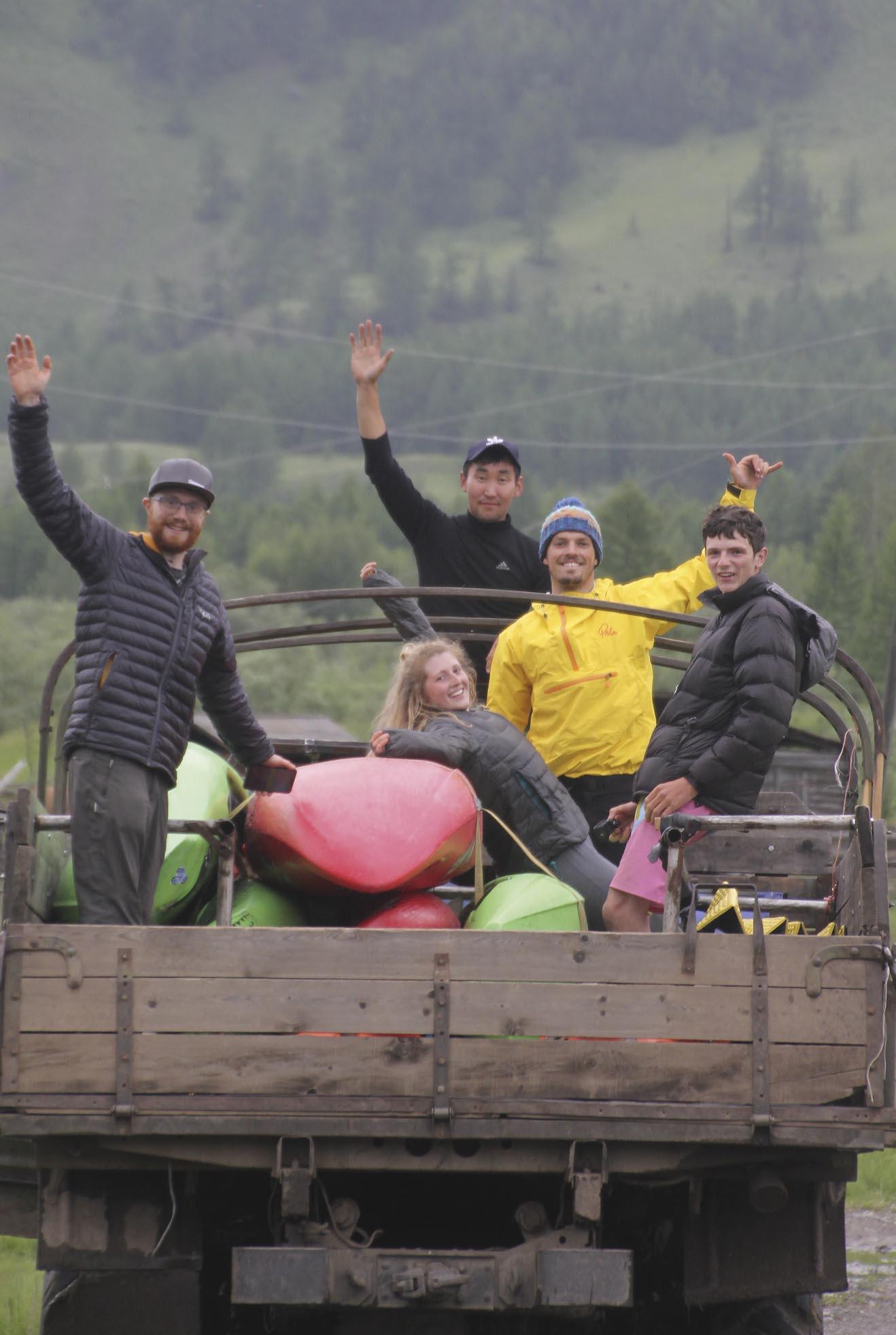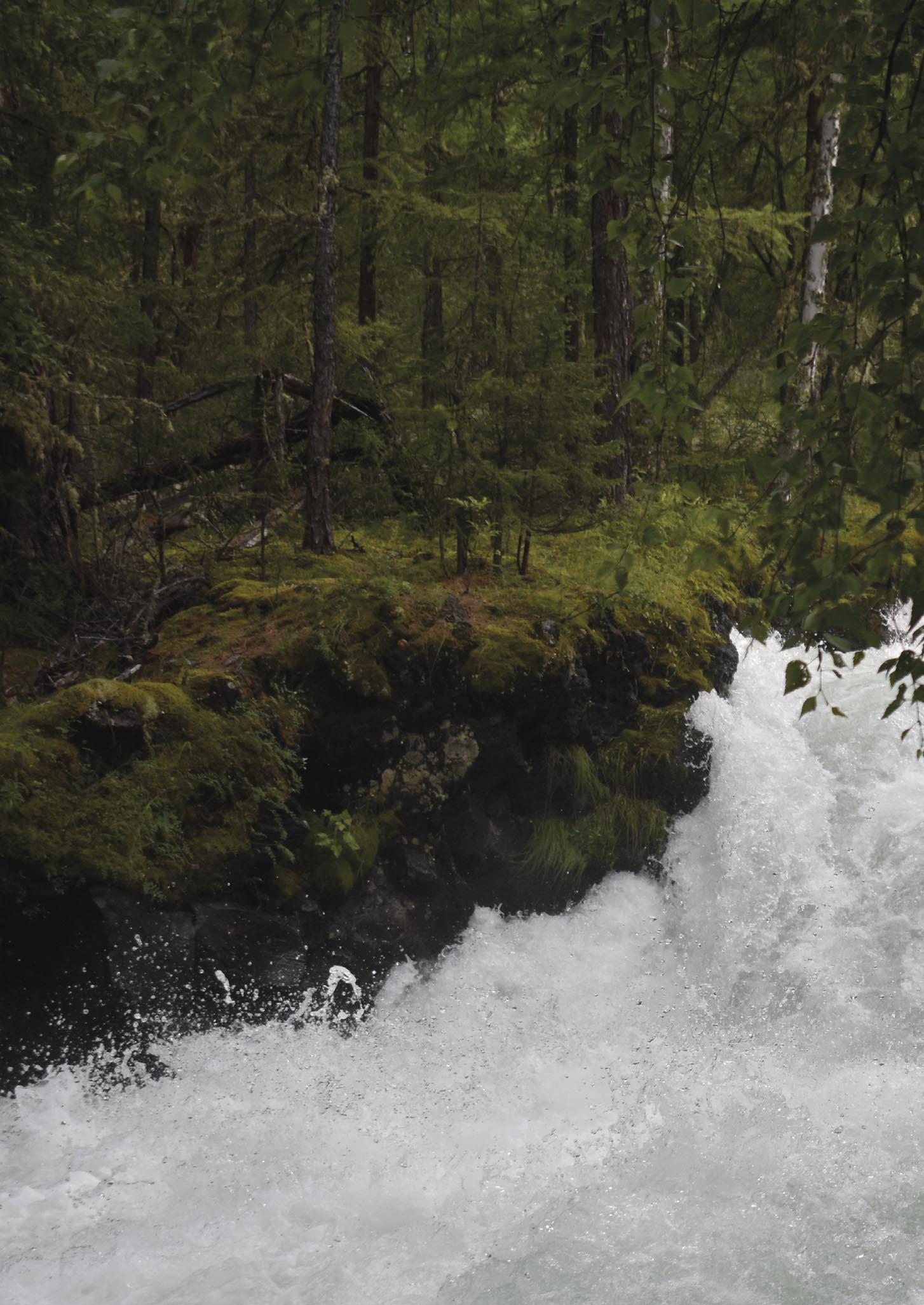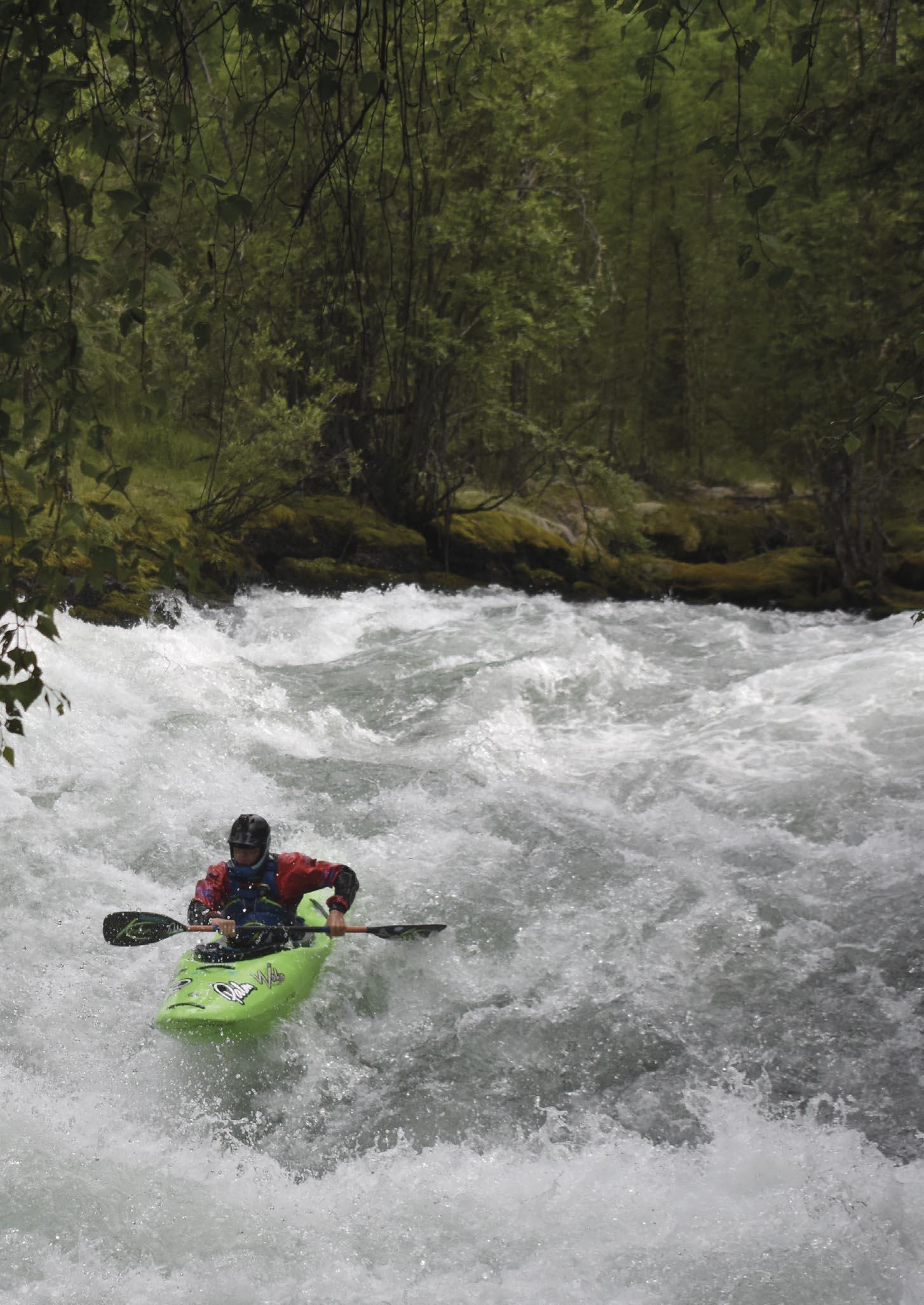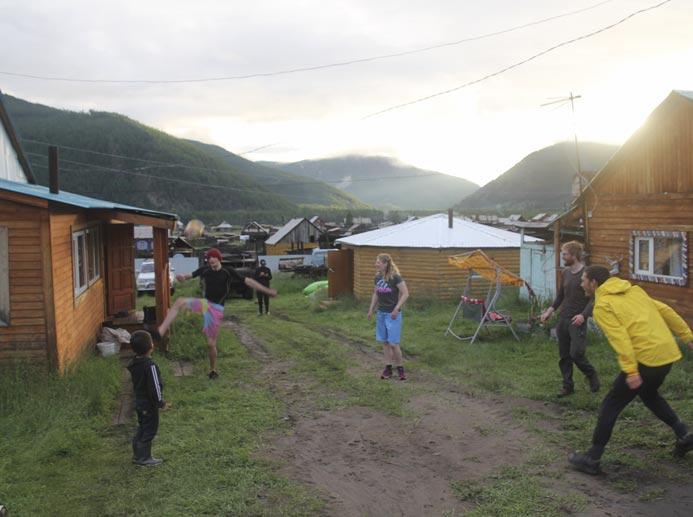
20 minute read
BUKE 2019
In June 2019 seven university kayakers set off to explore the rivers of far east Russia, amongst the wilderness of the Sayan Mountains and areas around Lake Baikal. The team: Jamie Peden, Joe Fender, Harry Turner, Adam Francis, Duncan Stewart, Cara Lee, Elliot Goddard. Words: Cara Lee and Jamie Peden Photos: Joe Fender and Harry Turner
WHAT IS BUKE?
Advertisement
The British Universities Kayaking Expeditions have been running every other year since 2005. University kayakers from across the UK send in applications; a successful 20 paddlers are invited to a selection weekend in north Wales the December before the trip. Throughout the weekend (rain-dependent) multiple rivers are paddled, and potential destinations for trips are discussed before a team of seven are selected by the group. The selected team are responsible for researching their chosen destination looking into costs, logistics, river difficulty and access. Previous trips have included locations such as the Philippines, Venezuela and Madagascar. For 2019 we decided to go somewhere equally as remote and adventurous: far east Russia.
PLANNING
The original destination set out was the Sikhote-Alin Mountains - as far east you can get in Russia, however, after some local knowledge we realised the scope for paddling that far east wasn’t entirely worth an expedition. We decided to visit our second intended location – Lake Baikal and the surrounding mountains, a slightly more explored area, with the security of classic sections accessible to paddle if things didn’t go to plan. Despite trips being run in the area, there was still plenty of scope for exploration and possible first descents given the right conditions. We went in early season (trips usually run in August) to make use of the high water to explore smaller rivers and tributaries. Over the seven weeks, we completed four multi-days ranging from three days to 11 days.
For efficient planning, we split the team into two: the Scottish boys on logistics (transport, accommodation, language and river scouting), and the rest of the team on grants, support and sponsors. Somebody put us in contact with a Russian guide named Evgeny who had limited kayaking knowledge. He agreed to help us with local logistics, such as a variety of complex permits. He gave us information on the widely available transport both around the city and the alternative modes required to get to rivers including trucks, aero boats and tanks. We flew with S7 airlines; there were limited options directly from the UK with boats, so we went via either Dublin or Dusseldorf. Some team members obtained 90-day ‘business’ visas, whilst a few opted for 30-day tourist visas due to other commitments meaning booked flights on various dates. Palm Equipment provided us out with the best gear to get us through the expedition, Dewerstone supplied us with trip t-shirts and Life Shorts 2.0 to keep cool while looking cool on those long hike ins or portages and Radical Rider/ Waka Kayaks sorted the team out with new boats. River Legacy kindly gives us the use of three Delorme inReach GPS Devices which were invaluable during remote multi-day trips away from any phone reception. It allowed us to keep in contact with drivers and the outside world and receive weather updates to aid our decision making when the thunderstorms hit.

River Selenginka
Four days, 12km and many lessons learned…
The first part of the team, consisting of Adam, Joe, Harry and Jamie, arrived in Irkutsk by various routes, staggered over two days and were collected from the airport by Evgeny, our Russian contact. In a haze of city heat and jet-lag, we rapidly ran numerous errands including last bits of kit and Russian sim cards on a variety of networks for maximum coverage. Having easy and cheap access to mobile internet proved invaluable throughout the trip. During this time, Evgeny very kindly allowed us to stay in his apartment and helped us with many of the things we needed for the expedition. After a few days in the city, the transport was organised to the first river, the Selenginka, a tributary of the Snezhnaya flowing down from the mountains on the south end of Lake Baikal. This involved a truck in taking us around the south end of the lake to the river one way, with the primary plan for return to the city, which did contain some uncertainty, being via the local train service on the trans-Siberian railway. Following an early start, we were dropped on a riverside track at a ram-shackled but guarded checkpoint upstream of the town of Vydrino. Ahead was 7km of walking to get to the confluence and the bottom of the white-water section with the most direct route being through the checkpoint. However, after some essential hand sign communications, it transpired the guard would require payment for us to pass the checkpoint on the track. Instead, we opted to cross the river and meet the trekking trail on the other side.
TAIGA FOREST
We had planned to walk to the confluence that day and spend the following day lapping the white-water section. Siberia had other ideas. Even with the best portage pack setup carrying a loaded boat is gruelling even on easy ground, and taiga forest is by no means easy ground. Between the constant steep climbs and descents, the baking heat, fallen logs and low hanging trees (which are quite a severe obstacle with a boat on your back) we progressed at around 1kmh. With frequent stops to rest and modify our variety of pack setups by evening, we had made it to 2.5km short of the confluence and resigned ourselves to stay the night on a beach between stunning forested peaks. The following morning, we left most of our kit at camp and set off carrying somewhat lighter boats along the path, and by mid-morning, we had reached the confluence. At the confluence, lay a collection of small buildings by the river, as we paused there, we were hailed by a Russian family on the opposite bank. After paddling over and a disjointed attempt at conversation, we established that they were trying to cross the vast river and wanted us to ferry their packs initially and then their children across. After some thought we obliged, precariously balancing bags and small children on our decks across the flow, then staying close at hand while the parents waded through the waist-deep current. That afternoon we wrestled our way up the final 4 km of steep trail contending with dense woodland and old landslides on the path before finally stumbling exhausted to the glassy, picturesque lake which was the put in for the section.
HARD-EARNED
Although we were tired, nobody was keen to wait too long before jumping on our first, hard-earned, whitewater of the trip. From here followed a few extraordinary kilometres of boulder-strewn rapids and small clean drops which did much to raise our spirits. We returned to camp as the sun was setting for another night. The following morning, we floated and paddled down out of the mountains back towards the road. As we came into the town, we were flagged down by some locals fishing on the bank who despite understanding nothing we said, spoke excitedly at us in Russian and provided us with tea, bread and the inevitable (and excellent) vodka. As we had a day to spare, we paddled down to the mouth and paddled



out on to the lake. It was stunning, calm as a mirror, with terns overhead and the occasional Lake Baikal seal popping up to investigate us. We camped that night on a picturesque beach at the river mouth with stunning views out over the lake and back up into the mountains, and the following day we paddled through an abandoned timber port and walked back through the town to the train station. After much Google translate to acquire the correct tickets and a long wait on the platform, as enormous freight trains thunder past, the local train finally arrived, and we bundled ourselves and boats aboard while a somewhat bemused looking conductor talked at us rapidly in Russian. That day we failed to make it back to Irkutsk and ended up spending a very damp half a night on the outskirts of the town of Sludyanka, crammed between the lake and the railway embankment, to then get an early train to the city the next morning. We moved into a hostel in the city to prepare for the rest of the team arriving the following days. During this time, somebody put us in contact with a local kayaker named Vladimir, who gave us a massive amount of valuable information which was incredibly helpful throughout the expedition. Cara arrived a couple of days before we were due to leave for the next river and the stoke was high however this did not last long when she came with the conspicuous absence of most of her equipment. Fortunately, this only delayed us by a day and after some struggle, her bags finally arrived in the Irkutsk.

River Kitoy
11 days, three rivers, 1,300m descent over 270km
In the East Sayan Mountain range, a seven-hour drive outside our base city Irkutsk, we arrived at the geton and filled our boats with gear and food before being left alone in the wilderness. Somebody had warned us about the high water levels of the Kitoy, and with rain thundering down during the drive, we naturally felt nervous. Jaw-dropping views soon eased our worries as we started to paddle down a bank full Kitoy. Two hours later we found a camp spot next to a track leading down to the river (used to drive to the other side in low levels). Despite this feeling of isolation from the real world, we heard a rumble in the distance. We knew that it wasn’t uncommon for bears to be intrigued by the smells of food and humans in these mountains, but luckily this wasn’t a bear. To our disbelief on the other side of the river a giant tank suddenly appeared, paused at the riverbank before ploughing across the river towards us. We stood stunned as four excited Russians jumped out. After some interesting translating, they invited us for a ride, and of course, we said yes. We rode on top of the tank through the river, down the track and back to camp. Afterwards, we shared drinks and stories (despite a significant language barrier) and realised that all of them, including the driver, were very drunk!
START OF THE FIRST GORGE
The following day we paddled into the ever steepening mountains, and as the river steadily ramped up in gradient, we reached the significant horizon line of Scots Drop, signalling the start of the first gorge. This entailed big water and big portages; we carried kit and boats separately as they were too heavy for one trip on the steep ground. The gorge contained several mighty rapids, which were far higher than any pictures we had seen previously. Cara and Elliot opted to portage the gorge in its entirety while Joe, Adam, Harry and Jamie proceeded tentatively, and ran all but the first fall. Heavy thunderstorms led to river levels rising rapidly on several occasions. We made use of this rain to check out a tributary of the Kitoy- the Ara-Oshi and one of its tributaries the Ara-Khabuty, leaving most of our kit at a base camp by the confluence. We suspected the Ara-Khabuty, a scrape on normal river levels, was a first descent. We hiked up to scout the river, on return to the confluence we found that the Ara-Oshi had risen a good foot, and was still rising. We paddled a very fast and brown tributary before quickly returning to base camp.




RELENTLESS RAIN
After a night of relentless rain, we decided it would be unwise to attempt the harder lower canyon at these levels and paddled down the flat section to check out another tributary, the Gorlyk Gol. The ‘flat’ section itself provided some big volume wave trains and one surprisingly huge river-wide hole that gobbled up some of the group and spat them back out! After a long and sweaty walk, we found a beautiful canyon, with plenty of gradients that surely would be a classic, if it were only slightly more runnable! Most of the rapids were continuous and bouldery with plenty of ugly siphons and undercuts, making a decent by kayak an unattractive proposition. It took another day for the Kitoy to drop back to a reasonable level. A well-rested team set off downstream in search of a large rock before the mandatory portage of the Grade 5+ rapid 47. We found the rock however it was now ¾ submerged and forming a siphon, confirming the river was still very high. Next up was the Biluti tributary. After stashing away kit safely taking enough for three days we set off on the gruelling hike up, a whole day of walking later we arrived at the ravine where we set up a Tyrolean Traverse to get the boats across to our camp for the night. Harry and Jamie made quick work of the ropes, and we passed boats across whilst the team abseiled down.
With little information on the whereabouts of the get-in for the Biluti, we headed off to try and find it. After four hours of walking, we came to the visible end of the path and headed down to the river, but we couldn’t see the drop in the picture. We were all tired, Cara decided to stay and relax by the river whilst the boys hiked up further to try and find the get-in. After another hour and a half and still no sign apart from boulder gardens the boys called it quits and paddled back to meet Cara. With the group back together, we set off down into an incredibly steep, tight and committing gorge. The final drop of the day was a 12m waterfall, an impressive must ‘plug’ fall that would take extra care to get the line right. Harry, Jamie, Adam, Duncan and Cara all decided that they were too tired after a monumental day of walking and paddling. Joe and Elliot ran the fall with good lines. To our dismay, it rained all night, and we woke to a raging Biluti, Harry and Jamie set off to scout the whole of the lower canyon, which was boxed in until the end by 50m high walls. Meanwhile, the rest of the team searched for a new access point to abseil into the gorge as large boils pushed the water into undercuts below the 12-metre waterfall. Luckily the canyon was good to go; it entailed sweet ledge drops and boulder garden rapids in an incredible location.

FUELLED UP ON PORRIDGE
We arrived back at the Kitoy (Biluti Base Camp) all somewhat depleted. The Kitoy had risen two metres, and we were keen to get on and paddle some huge Grade 3 water in the sunset, dodging bus-sized holes and riding well overhead height wave trains. Somebody told us to stop at some huts and banyas downstream before the 110km paddle out; however, on arrival at 21.00, we found it deserted. To paddle through the night had been considered due to the clear night and fast-flowing river. We fuelled up on porridge with plenty of melted snickers and coffee! Once the stars came out, we floated laid-back on our boats stargazing. With an incredible sunrise urging us to keep going, we arrived at 06.00 cold, sleepy and aching. The GPS stats read a total distance of 115km, an average speed of 14.3kph and a top speed of 27kph, taking eight hours to complete the paddle out. A shattered group tucked up into our sleeping bags for some well-earned rest before being woken up by blistering heat from the sun. On return to the city, we found that Evgeny and our driver Ivan had been somewhat concerned for our welfare, we had discovered that the Kitoy had gone in too far higher than typical flood with many local villages underwater. It was forecast to continue to rain. In hindsight we had been lucky to make it to below the lower gorge before the levels rose again; otherwise, we would have had a long wait on the bank or an arduous portage as it would likely have become un-runnable.
At this point, we moved into a new, more extensive and very reasonably priced hostel. The very friendly and enthusiastic (to have us wash) wardens kindly allowed us to store our boats in a spare room during our stay which made it a good base for planning our next river. We had hoped to attempt a less run river, the Onot, however some difficulties with acquiring the correct permits as well as the likely-hood of the recent rain making the access tracks impassable rendered this option not possible. We decided to head to the river Zhombolok (Jhom-bo-lok). Somebody told us that this river was fun, easy to access and Siberian paddlers set up camp for a few days to lap the 4km section of Class 4 white water.
Ivan brought us to a small village called Orlik where we loaded up an old Soviet truck that would drive us further into the Siberian wilderness. We drove up the valley, twisting through tight trees and charging through deep mud, at one point we were driving through the lake!

River Zhombolok
three days







Adam had scouted the Upper part of the Zhombolok on Fat Maps looking for some adventure and suffering, and he had seen potential rapids that we hadn’t heard of people paddling. The next day we hiked further upstream, we found the river along with multiple fallen trees and sieves, cautiously we paddled down a few beautiful sections of water. After a few mini portages to get to the main flow of the river, we found the first sight of white water – a small and technical river with clean boofs and fun surf waves. The following day we ran multiple laps of the 4km ‘Park and Huck’ section, it had big boofs, endless surf waves, technical ferry glides and eddy manoeuvres. We planned to head straight to the next river however a ride in the back of a truck in the rain and hail left us cold and miserable, and our driver offered us a night in a guest house which we gladly accepted. We enjoyed an evening exploring the local village, playing football with their family, eating Yak Dumplings and drinking some fine Russian Vodka, a great way to experience the real Siberian culture.

River Urik
eight days
We arrived at the Urik after a bumpy ride on the back of another soviet truck and jumped off before the road ran out. Whilst having lunch, we saw a small vehicle pass and were not surprised to see it get stuck in the mud beyond the road. It turns out they were the local park rangers; however, they had no clue how to get out of the mud - BUKE team to the rescue. We helped set wood under the tyres and tell the drivers which way to steer and drive, after a lot of pushing and mud splattering everywhere the vehicle made it out, only to
continue further down the field. We decided to get to the river asap before they got stuck again. After dragging heavy boats through a field to the high water get on, we set off on the beautiful but shallow Urik. Once we reached the main flow we started to feel the true remoteness of the river; we struggled to decide on a spot to camp as the forests that lined the river were dense and looked like the perfect home for bears. Eventually, as the team grew tired, we agreed on a slightly more open spot and made sure to tie our food high in the trees well away from camp. The first gorge consisted of a gentle warm-up with plenty of eddy hopping down to a large drop with a tree across almost the whole river, only Jamie decided to run this rapid and got through by sneaking down the right. After that, the big rapids and stoppers continued until reaching a boxed in canyon which we scouted from above. We took more time to relax and appreciate our surroundings on this river- reading, fishing and doing some yoga.
MULTIPLE RUNS DOWN THE WATERFALL
We hiked up another tributary to find a waterfall, however as the river below was too rocky to paddle we decided to only take two boats between us to lighten the load (a perk of everyone in the team paddling one of the same two boats). Multiple runs down the waterfall left us happy but exhausted as we returned to camp, picking up more wild rhubarb for dessert (making up for our poor attempt at fishing). Another warm-up section led us to the second gorge, steeper and more continuous than the first. A long flat paddle followed this before we saw the whole river drop off. Somebody told us of a portage around a 20+foot waterfall which we all secretly hoped would be clean and runnable. However, on


arriving, we immediately realised it was un-runnable with the left landing onto rocks and the right onto the wall before being piled back onto the left. We swam across below the waterfall to get a good look at what was behind before setting up camp nearby. On our paddle out we met a couple of Russian hikers who provided us with fish bigger than we could ever imagine catching, bread and fresh salad (a luxury). They told us about the events of their morning, crossing paths with a bear and killing it - initially, we thought this was some mistranslation, but they showed us a photo. They were shocked that we hadn’t come across a single bear during our trip (we were then grateful to be carrying big bright boats on our backs and taking care to store our food away from camp).
SPECIAL THANKS
Special thanks to Palm Equipment, Radical Rider, Dewerstone, SystemX, Benrhos Ltd, Bala Rotary Club, TJ composites, Redpoint Climbing Centre Worcester, Queen’s University Belfast, Bangor University, University of Worcester and Queens Collage Taunton.

THE ‘WORK CAMP’
They recommended a walkers hut 10km downstream, which had a banya. This camp became known as the ‘work camp’ as some of the team decided to retrieve fallen trees from the forest and use the saws and axes provided at the hut to chop the trees into firewood. We stayed here to recuperate, relax (and ‘work’) as well as give fishing another attempt before the final flat water 97km paddle out. We had pinpointed our get out which would involve a hike through a forest to the nearest village. When we arrived at the forest but it looked too dense to find a path, so we continued down to the closest point to the road and got out next to a Romany camp before meeting up with our driver and returning to the city. To end our trip we spent a few days travelling without our kayaks returning to Lake Baikal, exploring beautiful temples and hiking up mountains. Check out the videos from our trip on our Facebook: British Universities Kayak Expedition 2019 @ https://www.facebook.com/uniyaker/












